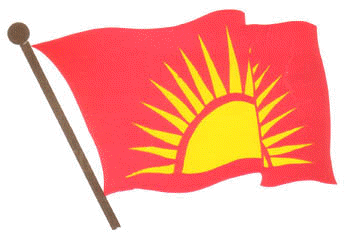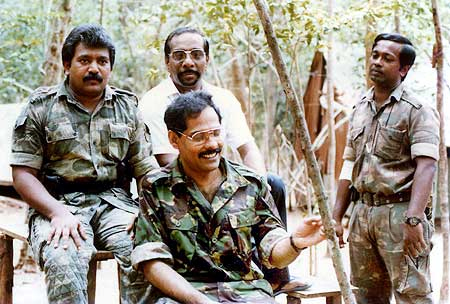Last week I had already explained that our leader had appointed me as the head of the Department of International Relations on the 1st of January 2009 and had informed the world leaders of the appointment on the 12th of January 2009.
I began working in my substantive role as soon as he had informed the world leaders of my appointment.
This period was a complex one. The Sri Lankan Government together with the support of the world had advanced beyond Kilinochchi in the war against our freedom struggle, our movement and our people.
Our liberation movement had never ever confronted a situation as critical as this before. It was difficult to face the occupation of the Sri Lankan military and to stop the advancing forces. As the ability to fight a war from multiple fronts became diminished, our leader decided to fight the war from a narrow front.
The Sri Lankan forces had abrogated all international conventions and were conducting the war in the most brutal fashion. With continuous artillery barrage and bombardment, on average a hundred civilians were being killed on a daily basis while hundreds more were being wounded. The embargo on food and medicine and multiple displacements were being forced on our people by the Sri Lankan government.
To face this brutal war, the people had to provide all the necessary resources including the personnel needed. The situation of our people was a painful one at this stage. The people were bearing the burden of the war beyond their means. The people of Vanni who had shouldered our movement and the struggle during these hard days had borne the pain and scars of the war.
In this predicament our leader was prepared to stop the war without compromising on the goal of the struggle. However, our leader was not convinced that the Sri Lanka would agree to nor would the international community facilitate such a ceasefire. Yet, he kept the doors open for such a ceasefire. On this basis, our movement had expressed its willingness to engage in a ceasefire or peace talks.
I began my role in these circumstances. By contacting the international governments I began working on creating a situation conducive for a ceasefire.
During the initial stages of my engagement with the international community they had already concluded that it would be difficult for our liberation movement to stop the advancing Sri Lankan force and win.
As a reflection of this position, the co-chairs including Norway, United states, Japan and the European Union insisted that we should lay down our arms. On this basis, on the 3rd of February, the co-chairs had put forward some advices.
This position of the co-chairs had been taken without any recognition of the legitimacy of the freedom struggle of the people of Tamil Eelam.
The laying down of arms, which should have been linked to a solution to the national question of the Tamil people had been placed ahead as a pre-condition to the ceasefire and peace talks.
By justifying the need to stop the killings and torture of our people by the Sri Lankan forces, the political surrender of the Tamils was forced upon them instead of resoling through a political process.
Our leader did not accept this position of the co-chairs.
We insisted with the co-chairs that any issue related to arms should be linked to the political solution that is reached through a political dialogue.
We re-iterated that a ceasefire and a peace dialogue was imperative to prevent the Tamil people being massacred, to seek a just political solution for the national question and to ensure peace and stability in the island and in the Indian Ocean region.
Even in the short time as I began working on a ceasefire, it became obvious that an unconditional ceasefire was not going to be feasible.
It was also easily obvious that the entire world was of one view in bringing the armed struggle of our liberation movement to a halt, in one way or the other.
I also became aware that the world was not going to save our people or our movement. The fundamental reason for this position was that our interests and the interests of the international community did not fall on the same line. I had informed this to our leader.
I began exploring every possibility that could bring together our interests and the interests of the international community onto a straight line and effect a ceasefire even if it was only for a short time. I thought through and put forward a plan to bridge the gap between the position of our movement and that of the international community, but this too came to no accord.
To detail this at this point in time may not be appropriate. We will discuss this more broadly at a future date when the time is right.
The month of April had arrived. It was clearly understood that the possibility of bringing a ceasefire and political negotiations had all but gone.
The people of Tamil Nadu and the Tamil Diaspora had been coming together in unprecedented numbers and protesting against the brutal war the Sri Lankan government was waging.
These protests, to a small extent, assisted in foreign nations applying pressure on the Sri Lankan government. However, the international community did not come forward to arrest Sri Lanka�s war efforts.
The realisation that an opportunity for a ceasefire was not forthcoming and the fact that our leader was directing the war on the front lines bothered me deeply fearing the safety of our leader.
Even after the fall of Killinochchi, our leader was insistent that at least a small piece of land should remain under the control of our movement.
He was very concerned for the safety and welfare of the families of the our freedom fighters, those civilians who had served in the governing structures of Tamil Eelam administration, their families, the supporters of the movement and the general public, if he withdrew into the jungle without keeping a piece of territory under the control of our liberation movement; in particular, he was not happy of the prospects of our people being subjected to torture and indignity in the hands of the Sri Lankan military.
Furthermore and most importantly, our leader had several tactics and strategies that could have forced the military into a death trap. As a result he himself was leading the fight in the battle fronts. If those strategies and tactics had succeeded the direction of the war would have turned upside down. A large number of the military that was occupying the Vanni would have perished in the same Vanni land. But, the unexpected demise of senior military commander Theepan with other senior military commanders and more than 500 other special forces in a military siege made it impossible to execute the plans of our leader.
Requests made by senior commanders on the ground and myself urging our leader to move to safer locations were not heeded by him when he was leading the fight in the ground. He was focussed on somehow break through the Sinhala military siege. Even though there was an acute shortage of personnel and materials, he confronted the enemy with a strong will.
After the fall of Theepan and other senior fighters our leader did relent to move to safer locations. There were three attempts at this. However, these were not successful due to fortification of the military that was impregnable without taking very high risks. Eventually our leader attained martyrdom fighting to break through the final siege of the enemy.
With our leader having attained martyrdom, the situation we face is in a new historical era. How are we going to confront this phase? We will meet again next week on the 22nd of July to discuss these circumstances.
Please send forth your opinions that you wish to share to the email address below. I wish to publish some of these in this web site. Please inform me if you do not wish your comments to be made public.
The email address to receive your comments or opinions is: [email protected]
Thank you
Respectfully
KP
15.07.2009


